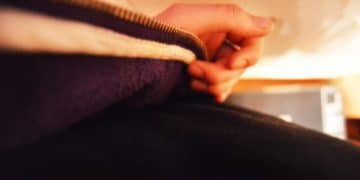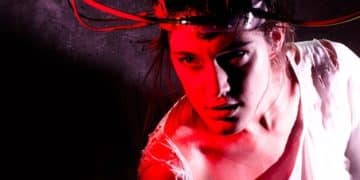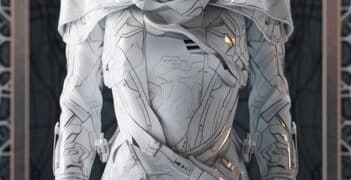Cosplay LED Lighting Guide: Illuminate Your Costume Perfectly
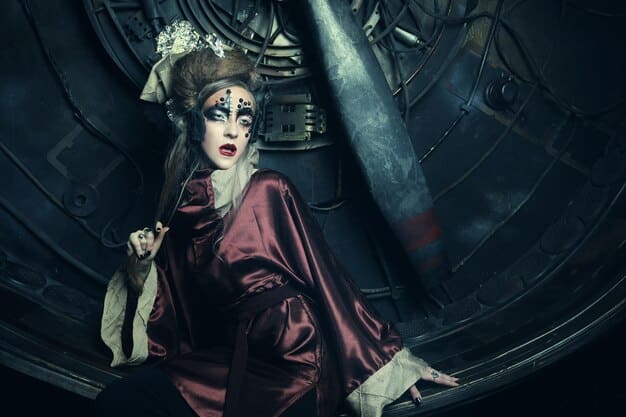
Cosplay LED lighting enhances costumes by adding vibrant, dynamic effects, transforming ordinary outfits into stunning, eye-catching creations that captivate audiences and elevate the overall cosplay experience.
Ready to take your cosplay to the next level? Our cosplay LED lighting guide is here to help you illuminate your costume for maximum visual impact, turning heads and winning competitions.
Understanding Cosplay LED Lighting Basics
Cosplay LED lighting is more than just adding lights to a costume; it’s about creating an immersive and captivating visual experience. This section covers the fundamental concepts you need to know to get started.
Why Use LEDs in Cosplay?
LEDs offer a range of benefits for cosplayers, from energy efficiency to versatility. Knowing these advantages can help you make informed decisions when planning your lighting.
- Energy Efficiency: LEDs consume significantly less power than traditional light sources, allowing for longer use without frequent battery changes.
- Versatility: Available in various colors, sizes, and shapes, LEDs can be easily integrated into different costume designs.
- Durability: LEDs are robust and can withstand the rigors of cosplay events, including movement and occasional bumps.
- Brightness Control: Many LEDs offer adjustable brightness, allowing you to fine-tune the lighting to suit different environments.
LEDs, therefore, not only enhance the visual appeal of your cosplay but also offer practical advantages that make them a favorite among cosplayers.
Types of LEDs for Cosplay
Choosing the right type of LED is crucial for achieving the desired effect. Different types of LEDs have varying characteristics, making them suitable for specific applications.
- Strip LEDs: Flexible and easy to cut to size, strip LEDs are ideal for outlining costume elements or creating linear lighting effects.
- Single LEDs: Small and versatile, single LEDs can be used for detailed accents or embedded in props.
- Addressable LEDs (NeoPixels): These LEDs allow individual control of color and brightness, enabling complex lighting patterns and animations.
- EL Wire: A flexible wire that glows when electricity is applied, EL wire is perfect for creating glowing outlines or details.
Understanding the strengths of each type of LED will enable you to select the best options for your specific cosplay project.
By understanding the basics, which involves grasping the types and advantages of LEDs, cosplayers can set a strong foundation for creating visually stunning and impactful costumes, making the learning part less hard.
Planning Your Cosplay LED Integration
Effective cosplay LED integration requires careful planning and design. This section provides essential tips and techniques to help you seamlessly incorporate lighting into your costume.

Sketching and Design Considerations
Before you start wiring LEDs, create a detailed sketch of your costume and identify where you want to incorporate lighting. Consider the overall aesthetic and how the lighting will enhance your design.
- Placement: Determine the best locations for LEDs to highlight key features and create visual interest.
- Color Scheme: Choose a color palette that complements your costume and enhances the character’s design.
- Power Source: Decide on the type of battery pack or power supply you will use, considering its size, weight, and power output.
Planning these elements in advance will save you time and effort during the construction phase.
Wiring and Circuit Design
Understanding basic wiring principles is essential for creating a safe and functional cosplay lighting system. Plan your circuits carefully to ensure proper power distribution and prevent short circuits.
- Series vs. Parallel: Decide whether to wire your LEDs in series or parallel, considering the voltage and current requirements.
- Resistors: Use resistors to limit the current flowing through the LEDs and prevent them from burning out.
- Switches: Incorporate switches to easily turn the lighting on and off, preserving battery life.
Proper wiring and circuit design will ensure that your LEDs function correctly and safely.
In essence, integrating LEDs into your cosplay requires a holistic approach, focusing on design aesthetics and practical electrical considerations, culminating in a well-lit and visually appealing outfit.
Selecting the Right LED Components
Choosing the right LED components is essential for achieving the desired lighting effects in your cosplay. This section provides a guide to selecting the best options for your project.
Choosing LEDs for Brightness and Color
The brightness and color of your LEDs will significantly impact the visual impact of your cosplay. Consider the environment in which you will be wearing the costume when selecting LEDs.
For indoor events, lower brightness LEDs may be sufficient, while outdoor events may require brighter LEDs to stand out. Also, consider your chosen character’s aesthetic; are specific color palettes part of the costume?
Power Supplies and Battery Options
The choice of power supply will affect the weight, size, and runtime of your cosplay lighting system. Consider options like battery packs, USB power banks, or even AC adapters depending on your needs.
- Battery Packs: Portable and convenient, battery packs are ideal for cosplays that require mobility.
- USB Power Banks: Versatile and readily available, USB power banks can power a variety of LED setups.
- AC Adapters: For stationary cosplays, AC adapters provide a reliable power source without the need for batteries.
Selecting the right power supply will ensure that your LEDs remain lit throughout your event.
Correctly selecting your LEDs’ brightness and power requirements is crucial for a seamless and impressive lighting effect during your cosplay, ensuring that your design stands out for the right reasons.
Constructing Your LED Cosplay
With the planning and component selection complete, it’s time to begin constructing your LED cosplay. This section provides practical tips and techniques for safely attaching and wiring LEDs.
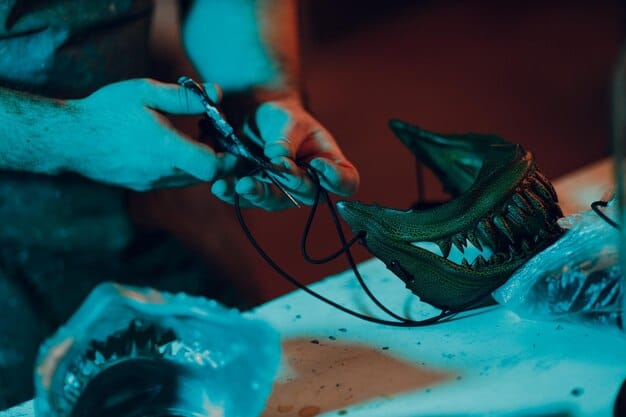
Attaching LEDs to Fabric and Props
Securing LEDs to your costume requires careful consideration of the materials and design. Use adhesives, stitching, or mounting brackets to firmly attach the LEDs without damaging the costume.
For fabric, consider using fabric glue or sewing the LEDs in place. For props, use epoxy or mounting brackets to ensure a secure attachment.
Wiring Techniques and Safety Tips
Proper wiring techniques are essential for creating a safe and reliable cosplay lighting system. Use heat shrink tubing to insulate connections and prevent short circuits. Always double-check your wiring before powering on the LEDs.
- Heat Shrink Tubing: Insulates connections and prevents short circuits.
- Wire Management: Keep wires organized and out of the way to prevent tangling.
- Safety Glasses: Protect your eyes while soldering or working with electrical components.
Following these wiring techniques and safety tips will ensure that your LEDs function correctly and safely.
Proper wiring techniques and strategic attachment of LEDs are not only important but essential for not only a visually appealing and safe outcome, but also for ensuring the overall longevity of your cosplay.
Advanced LED Techniques for Cosplay
Take your cosplay to the next level with advanced LED techniques that create dynamic and captivating lighting effects. This section explores various methods to enhance your costume.
Programmable LEDs and Microcontrollers
Programmable LEDs, also known as NeoPixels, offer individual control of color and brightness. Combined with microcontrollers, these LEDs can create complex lighting patterns and animations.
Use microcontrollers like Arduino or Raspberry Pi to program custom lighting effects, adding a unique touch to your cosplay. These devices allow for precise control and customization of your LEDs.
Reacting to Music and Movement
Make your cosplay interactive by programming LEDs to react to music or movement. Use sensors to detect sound or motion and trigger corresponding lighting effects.
Consider using sound sensors to synchronize your LEDs with music or accelerometer sensors to react to your movements. These features add a dynamic element to your cosplay, making it more engaging.
Through understanding the use cases of programmable LEDs and combining them with devices such as microcontrollers, your cosplay will elevate past visually appealing to fully interactive.
Troubleshooting Common LED Issues
Even with careful planning, LED issues can arise during the construction or use of your cosplay. This section provides troubleshooting tips for common problems.
LEDs Not Lighting Up
If your LEDs are not lighting up, start by checking the power source and connections. Ensure that the battery is charged and properly connected to the circuit. Check for any loose wires or short circuits.
Use a multimeter to test the voltage and current in the circuit. Replace any damaged components or wires.
Flickering or Dimming LEDs
Flickering or dimming LEDs may indicate a low battery or voltage drop. Try replacing the battery or using a higher voltage power supply. Check the connections for any corrosion or loose wires.
Clean any corroded connections and tighten any loose wires.
Being able to solve issues with LEDs will allow you to save a lot of time by preventing major problems. When you are ready to showcase your hard work, you will be able to address these problems quickly.
| Key Point | Brief Description |
|---|---|
| 💡 LED Types | Understanding types like strip, single, and addressable LEDs is crucial for specific effects. |
| 🔋 Power Options | Battery packs, USB power banks, and AC adapters each offer different advantages based on portability and power needs. |
| 🛠️ Wiring Techniques | Proper wiring using heat shrink tubing ensures safety and prevents short circuits. |
| ✨ Advanced Effects | Enhance your cosplay with programmable LEDs and sensors for music-reactive or movement-reactive effects. |
FAQ
▼
EL wire and flexible LED strips are excellent for outlining shapes due to their flexibility. They can easily bend to the desired form, providing a smooth, continuous line of light.
▼
Consider using a slim USB power bank or small lithium-ion battery. These options are lightweight and can be easily concealed within your costume while offering sufficient power for LEDs.
▼
Use fabric glue or carefully stitch the LEDs onto the fabric, ensuring not to puncture any wires. Apply a thin layer of fabric glue to prevent damage and ensure a secure hold.
▼
Ensure you are using the correct resistors to limit the current flowing through the LEDs. Also, use LEDs designed for the appropriate voltage to prevent them from overheating and potentially causing damage.
▼
Yes, you can control multiple LED colors using a microcontroller like Arduino. Addressable LEDs, such as NeoPixels, allow individual control of each LED’s color and brightness through programming.
Conclusion
Illuminating your cosplay with LED lighting not only enhances its visual appeal but also brings a unique, eye-catching dimension to your character. By understanding the basics, planning carefully, and mastering advanced techniques, you can create stunning costumes that will impress audiences and judges alike. Whether you’re a beginner or an experienced cosplayer, the world of LED lighting offers endless opportunities for creativity and innovation.

